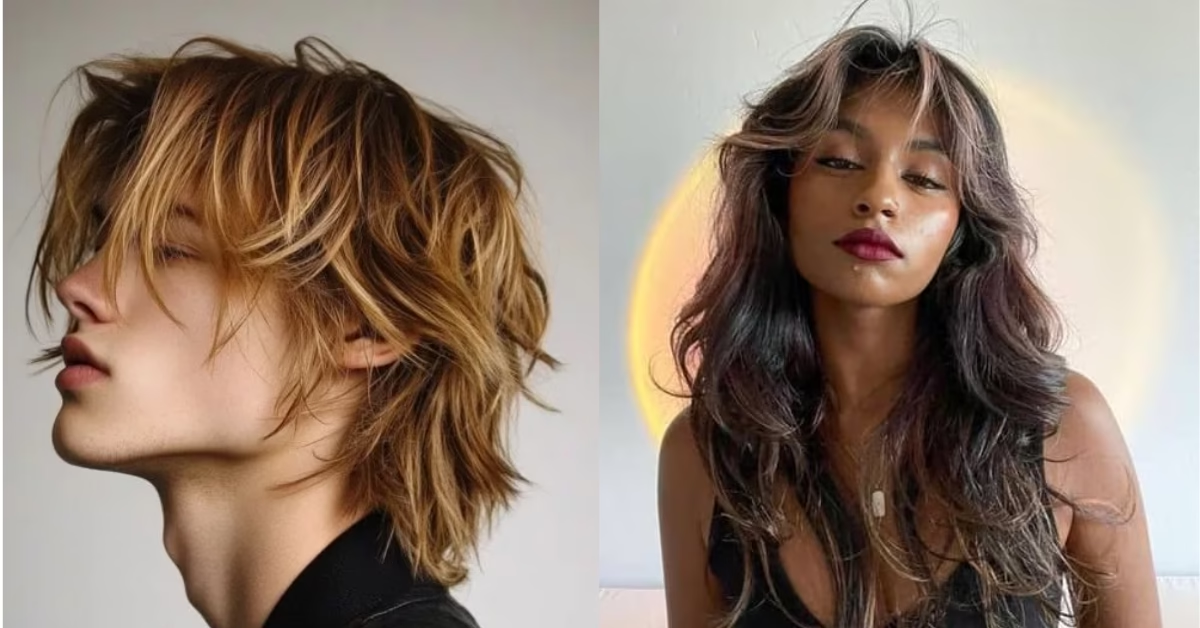The wolf cut has recently taken the hairstyling world by storm, becoming one of the most coveted haircuts for people seeking a fun, edgy, and bold look. A mix between the shag haircut and mullet, this versatile style is all about layers, volume, and texture. Whether you have short, medium, or long hair, the wolf cut can be customized to suit your individual taste. In this wolf cut tutorial, we will walk you through the steps to achieve this trendy haircut, tips on styling, and everything you need to know about maintaining it.
What is a Wolf Cut? Understanding the Trendy Hairstyle
The wolf cut combines the layered, textured vibes of a shag cut with the more extreme length differences of a mullet. Think of it as a modern take on retro styles, with added volume, shorter layers around the crown, and longer, more textured pieces at the back. It’s a wild, messy look that’s totally on trend, especially among younger people.
The key features of a wolf cut are:
- Layers: Plenty of them, giving it a voluminous, textured appearance.
- Choppy Ends: The bottom part of the cut is often left messy and uneven.
- Volume at the Crown: Like a shag, the hair is usually cut shorter around the top and longer at the bottom.
This haircut is perfect for those who want to stand out and embrace a unique, stylish look. It can be adapted for all hair types, whether straight, wavy, or curly, and looks especially good when paired with bangs.
Step-by-Step Wolf Cut Tutorial for Beginners
If you’ve decided to try the wolf cut on your own, it’s essential to follow a methodical approach. Here’s a step-by-step tutorial on how to achieve the perfect wolf cut.
Step 1: Gather the Right Tools
Before starting, make sure you have the following tools:
- Sharp hair cutting scissors
- A fine-toothed comb
- Hair clips for sectioning
- A mirror (preferably one that gives you a 360-degree view)
- Texturizing shears (optional, but useful for blending)
Step 2: Section Your Hair
Start by dividing your hair into sections. Use the comb to part your hair down the middle, then clip the top half of your hair away, leaving the bottom half free. This will allow you to work on one section at a time.
Step 3: Cut the Layers
Begin cutting the first section at the back. The trick to achieving a wolf cut is to create layers of varying lengths. Start with a longer base at the bottom and gradually shorten the layers as you move upward. If you’re aiming for a drastic wolf cut, ensure that the layers are distinct and choppy. Keep the length longer at the back, and shorter layers around the crown.
Step 4: Add Texture
Use the texturizing shears to remove some of the bulk in the layers. This will give the hair that signature messy, voluminous look. Don’t be afraid to get a little rough with the cutting; it’s all about creating texture and volume.
Step 5: Cut the Front Layers
Once the back is done, focus on the front. Depending on your preference, you can cut bangs or leave the front layers slightly longer. Make sure the front layers blend well with the back, maintaining a smooth transition.
Step 6: Final Touches
Once all the layers are cut, check for evenness. Make any necessary adjustments to the length and texture, and clean up any uneven areas. It’s always good to trim a little at a time, especially when creating a bold cut like the wolf cut.
How to Style Your Wolf Cut for Different Looks
The wolf cut is all about flexibility, and there are various ways you can style it to match your mood or the occasion. Here are some tips for styling your wolf cut:
1. Messy and Tousled
For a carefree, messy look, apply a texturizing spray or sea salt spray to damp hair. Scrunch the hair with your fingers and let it air dry. This gives your cut a lived-in, voluminous texture.
2. Sleek and Polished
If you prefer a more refined style, use a flat iron to smooth the hair. Focus on the longer layers at the back while leaving the crown slightly lifted for volume. You can also apply a lightweight serum to add shine.
3. With Bangs
Bangs pair wonderfully with the wolf cut. Style your bangs with a round brush while blow-drying to create volume and movement. For a more dramatic effect, try curtain bangs that blend into the layers.
4. Curly or Wavy Texture
For curly or wavy hair, embrace the natural texture. Use a curling cream or mousse to enhance your waves, and scrunch your hair for a beachy vibe. This will add extra volume and emphasize the layers.
Wolf Cut vs. Shag Cut: Which is Better for You?
Both the wolf cut and shag cut offer a similar layered, textured look, but there are key differences between the two. Let’s compare:
Wolf Cut
- More dramatic layering: The layers are usually more defined, with sharp contrasts between short and long sections.
- Volume: The wolf cut has more volume at the crown and a messier, more unkempt finish.
- Longer Back: The back tends to be longer than the front, which gives it a distinctive, asymmetrical look.
Shag Cut
- Uniform layers: The shag cut tends to have more consistent layers throughout the hair.
- Less volume at the crown: It’s more about the overall messy texture rather than creating height at the top.
- Can be more subtle: A shag cut is often easier to maintain and can look more subdued compared to the bold wolf cut.
Which One to Choose?
If you want something with more volume, texture, and a daring, edgy vibe, the wolf cut is the better choice. If you prefer a slightly more laid-back, classic layered look, the shag cut might be a better fit.
Choosing the Right Tools for a Perfect Wolf Cut
To achieve a perfect wolf cut, it’s essential to use the right tools. Here are some recommendations:
- Sharp Cutting Scissors: A pair of high-quality scissors is a must. Avoid using regular household scissors, as they can create blunt cuts that don’t blend well.
- Texturizing Shears: These shears help add texture and remove excess bulk, which is key to achieving the choppy, voluminous look of a wolf cut.
- Combs and Clips: Sectioning is crucial when cutting layers. A fine-toothed comb and hair clips will help keep things organized.
- Blow Dryer and Round Brush: For styling, a blow dryer and round brush can help create volume at the crown and define the layers.
- Hair Products: Use a texturizing spray, dry shampoo, or sea salt spray to enhance the natural texture of your cut.
Wolf Cut for Short Hair: How to Make It Work
The wolf cut works beautifully on short hair too! Here’s how to adapt it for short hairstyles:
- Start with a Basic Bob or Pixie Cut: The wolf cut on short hair usually begins with a bob or pixie cut, with layers added throughout.
- Focus on the Layers: Instead of long back layers, the back will be slightly shorter, but still choppy. The goal is to add volume and texture to the crown.
- Layered Bangs: If you have a shorter cut, consider adding bangs to frame the face and blend seamlessly with the layers.
Maintaining Your Wolf Cut: How Often Should You Trim It?
The wolf cut requires regular maintenance to keep the layers sharp and fresh. Since it’s a layered cut, you’ll need to trim it every 6 to 8 weeks to prevent the layers from growing out unevenly. Depending on how fast your hair grows, you may need to adjust the frequency.
Common Mistakes to Avoid When Getting a Wolf Cut
While the wolf cut is a fun and trendy style, it’s important to avoid certain mistakes:
- Cutting too much at once: Take your time when cutting, especially around the crown. Start small and gradually work your way to the desired length.
- Skipping texture: Without enough texture, your cut may look too heavy. Use texturizing shears to create a layered effect.
- Not adapting to your hair type: Make sure to tailor the cut to your natural hair texture. What works for straight hair may not look the same on curly hair.
You May Also Like: Is Propel Water Good for You? Benefits, Ingredients & Health Facts
Conclusion
The wolf cut is a bold and exciting way to express your personality through your hairstyle. By following this detailed tutorial, you can confidently create a chic, textured look with layers that add volume and shape to your hair. Remember, the key is to embrace the messiness and volume that come with this haircut. Whether you have short, medium, or long hair, the wolf cut can be tailored to suit your needs and style.
FAQs About the Wolf Cut Tutorial
- What is the difference between a wolf cut and a shag cut?
- The wolf cut has more dramatic layering with volume at the crown, while the shag cut has more uniform layers and less height.
- Can I do a wolf cut at home?
- Yes, as long as you have the right tools and are patient with the process, you can achieve a wolf cut at home.
- How often should I trim my wolf cut?
- You should trim your wolf cut every 6 to 8 weeks to maintain the shape and texture.
- What products should I use to style a wolf cut?
- Texturizing spray, dry shampoo, and sea salt spray work well to enhance the layers and volume of a wolf cut.
- Can I add bangs to my wolf cut?
- Yes, bangs complement the wolf cut perfectly, adding more edge and framing your face.
- Is the wolf cut suitable for curly hair?
- Yes, the wolf cut can be adapted for curly hair. It will add volume and texture to your natural curls.
- What face shape suits the wolf cut?
- The wolf cut works well with most face shapes, but it’s particularly flattering on oval and square faces.
- How can I maintain the texture of my wolf cut?
- Regular trims and using the right styling products, like texturizing sprays, will help keep the texture intact.

Evelyn White is an experienced content writer with a background in lifestyle, trends, and practical advice. With several years of writing across digital platforms, she specializes in making everyday topics accessible, informative, and engaging. Her goal is to deliver trustworthy, reader-focused content that’s both useful and easy to understand.
Discover more from Try Hard Guides
Subscribe to get the latest posts sent to your email.

